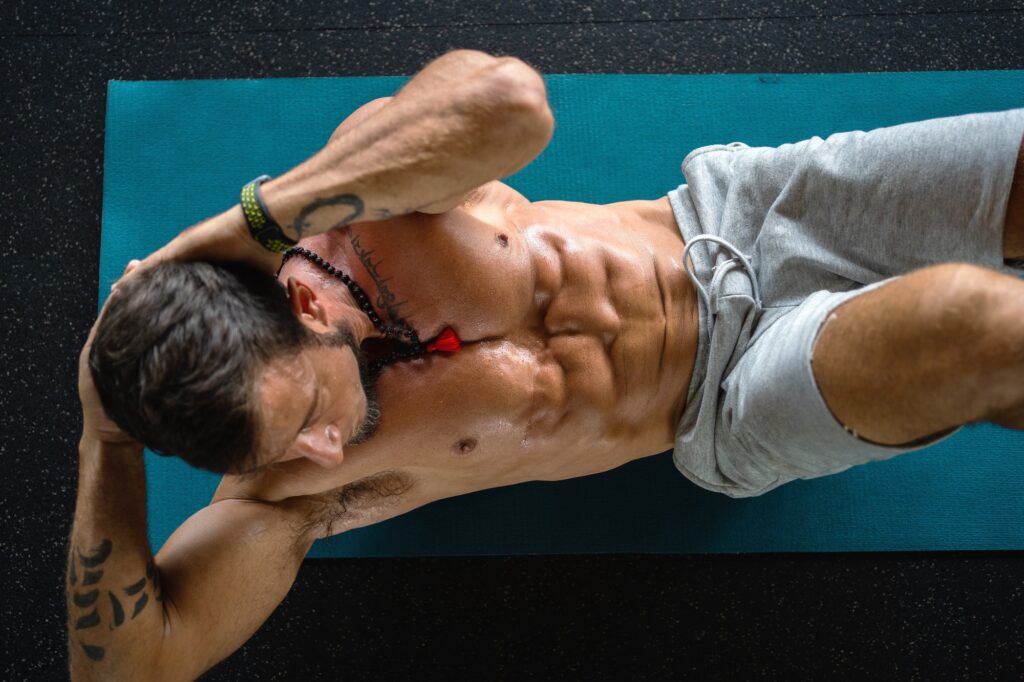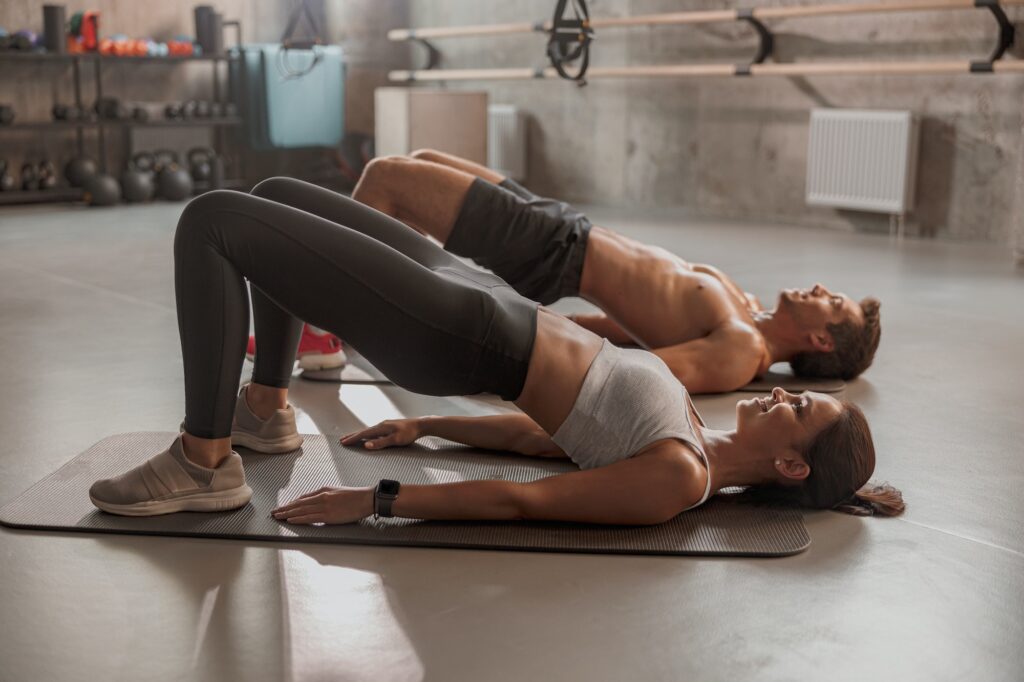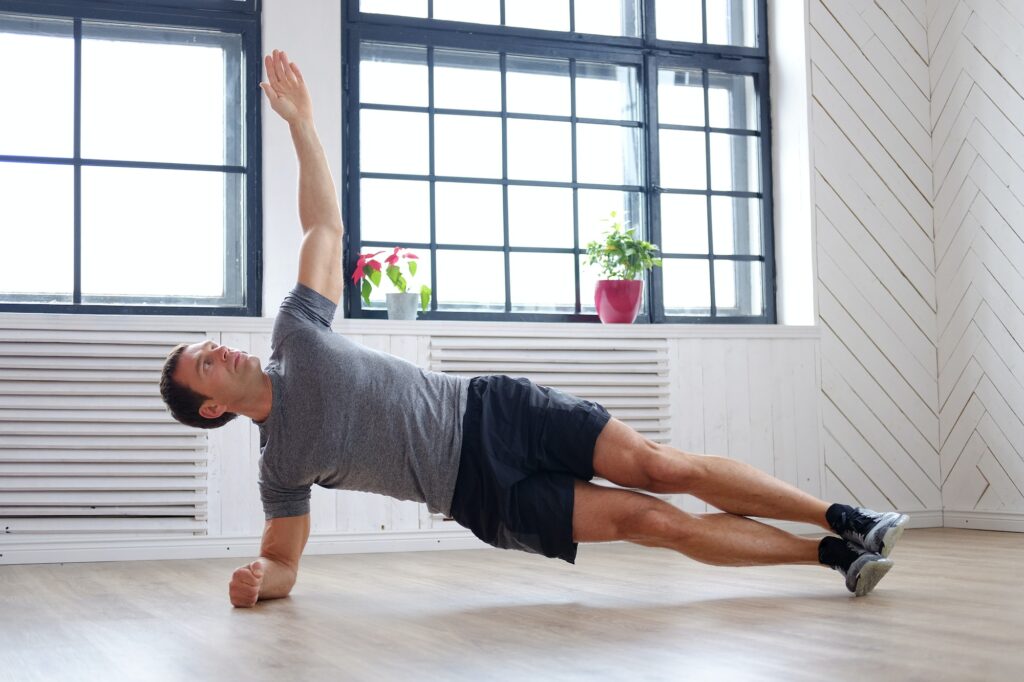Increasing your core strength is essential to build a strong foundation and prevent injury. When you work your core muscles, you improve your balance, overall strength, posture, stability, and more!
So, what should your beginning core workout look like? What are some of the best core exercises? We’ve got a few ideas. But before we dive in, let’s take a brief look at what exactly is meant by the term “core.”
What is the “Core”?
The core refers to your glutes, lower back, obliques, transverse abdominis, rectus abdominis, and more. Essentially, any muscle that is at the center of the body and works in some shape or form to help stabilize the trunk is part of the core.
In many uses of the word, the hamstrings, hip flexors, and other lower and upper body muscles can be grouped in with “core.” However, for the sake of this article and the exercises below, we’ll primarily be focusing on the abdominal muscles, obliques, and glutes.

Why Should You Perform a Core Workout?
First up, no, the major goal of a core routine isn’t to get that six-pack. Although, for some, this can be a great side effect! At the same time, not everyone can easily build a six-pack, so let’s back up and take extreme aesthetic goals out of the equation.
Building a solid core can help you maintain form in other exercises, such as the squat and deadlift, preventing injury and keeping your body strong and agile. In fact, core exercises are a key ingredient when it comes to preventing back pain.
When working in a physical therapy clinic, we noted that many back patients had a weak transverse abdominis (a muscle located in the lower abs). Thus, many rehab exercise programs for these patients revolved around strengthening this muscle.
Surprisingly, some of these patients even had really low body fat and six-pack abs but still had a weak transverse abdominis muscle. By specifically targeting this area of the body, as you would during upper body and lower body days at the gym, you can ensure you don’t end up with back pain or other injuries relating to a weak core.
What is Needed For Your Beginner Ab Workout?
This workout involves no equipment beyond a yoga or exercise mat. However, if you did want to make some of these moves more challenging, you can add a dumbbell or two (if available). Alternatively, resistance bands can also help you progress these exercises as they become easier.
In fact, you don’t even need a gym for these exercises. You can easily add this into any existing home workout, keeping it ultra simple by using only your bodyweight. You choose your level of difficulty based on your fitness level.

As you gain core strength, you may want to add other equipment, such as pull up bars, to add variation to your ab workout. Yet, again, this is entirely up to you and this might even be a decision you won’t have to make for a while yet (especially if you’re just starting out in the core realm of things!).
How to Do A Beginner Core Workout
The following glute and ab exercises will help you build a strong core. Before getting straight to it, make sure you perform a proper warm up, such as running on the spot, jumping jacks, and other movements.
Grab some water and let’s get to work!
Bicycle Crunch
Begin this exercise by lying face-up with your knees bent and your feet flat on the ground. Place your hands behind your head with your elbows pointing out and away from your body. Slowly bring your left leg in (keeping your knee bent) and bring your right arm in, touching your elbow almost touching your elbow your left knee. At the same time, straighten your right leg, without letting your foot touch the ground. Then, bend your right knee, bringing your left elbow to your right knee and straightening your left leg. Continue to alternate sides, performing this exercise for 12-15 reps and 2-3 sets.
TIP: Make sure you’re keeping your chin tucked and your abs tight. Don’t allow your lower back to come up off the ground or mat. This ensures you’re working your core muscles and not compensating in any other way.
Front Plank
Begin on all-fours. If available to you, extend your legs back and come up onto your toes, creating a straight line from your head to your heels. If this isn’t available to you quite yet, walk your hands forward so that your body creates a straight line from your head to your knees. If more comfortable, drop to your forearms and elbows. Hold here for 30 seconds to a minute.
TIP: Make sure to pull your core inward, without letting your belly drop or your lower back dip and ensure you’re squeezing your glutes! In terms of form, check to make sure your hands are directly under your shoulders.
Still not sure how to do it? Watch this video:
Side Plank
This is similar to the front plank but is, instead, performed on each side. Begin by lying on your side and stacking your legs on top of one another. Place your left elbow on the ground, right below your shoulder. Gently lift up, keeping your knees on the ground, if you need to. Hold here for 30 seconds to a minute, then switch sides.
TIP: Try to squeeze your obliques so your body doesn’t sag in the middle. Using a mirror here can also be helpful to make sure you aren’t leaning too far forward or backward.
For further instruction, check this video out:
Dead Bug
Begin by lying face-up. Bend your knees and lift your feet off the ground so that your calves and shins are parallel to the ground. Extend your arms straight up. Squeeze your core, and slowly lower your right leg in front of you and your left arm behind you at the same time. When they almost reach the ground, pause, then return to your starting position. Perform 10-15 reps for 2-3 sets.
TIP: This is another exercise where you want to ensure your lower back remains on the ground. When this becomes easy, you can amp up the difficulty by adding a weight in your hands or by lowering your legs and arms all at the same time.
For more direction on how to perform this one, watch this video:
Glute Bridge
This one, in particular, is good for the booty! Begin by lying face-up with your knees bent and your feet flat on the ground. Place your hands and arms flat on the ground on each side of your torso. Squeeze your glutes and slowly lift your hips up and off the ground. Pause at the tope, and slowly lower. Repeat for 10-15 reps and 2-3 sets.
TIP: Only lift so far that your body creates a straight line from your knees to your shoulders. Make sure your squeezing those glutes all the way up! For an extra challenge, add a weight on top of your hips (using a towel as a cushion can ensure it doesn’t dig into your hip bones!).
If you want more instructions on how to perform the glute bridge, watch this clip:
Supine Toe Taps
Start lying face up with your knees bent and your feet off the ground. Your shins and calves should start parallel to the ground. Engage your core by imagining a tight rope pulling your hips bones together (this should target your transverse abdominis muscle specifically!), then slowly lower one leg, while keeping your knees bent. Touch your foot to the ground, then bring your leg back to the start position. Alternate sides for a total of 12-15 reps and 2-3 sets.
TIP: Place your hands face down on the ground for added stability, and ensure your lower back isn’t coming up off the mat or ground.
This video offers a visual demonstration:
Heel Touches
Similar to other exercises, begin lying face-up with your knees bent and your feet flat on the ground. Gently lift your head and shoulders off the ground, reach your right arm to your right foot, then returning to center, then reaching your left arm to your left foot. Continue to alternate side for 15-20 reps and 2-3 sets.
TIP: Use this exercise to finish off your core routine for a quick last burn of those core muscles!
Not sure exactly how to perform this one? Watch this:
Programming (How to Add It to Your Workout, Life, Routine)
If you’re already strength training, you can add this routine to your already existing program. It can be a great way to finish off a lower body or upper body day. Alternatively, you can also add this into a cardio routine.
As previously mentioned, you can also add factors to progress the above exercises, such as dumbbells, resistance bands, or exercise variations (such as lowering both legs and arms at the same time!).
If you experience pain during these exercises, stop and adjust your form. If the pain continues, move onto the next exercise. If the pain is severe or continues throughout all of the exercises, it’s likely a good idea to book an appointment with your doctor or physical therapist to get to the bottom of it.
Did You Know?
- Some people can’t achieve a six-pack, no matter how hard they try! Experts claim this comes down to genetic factors, where, naturally, some people carry more fat around the middle than others.
Final Thoughts…
Whether you want to tighten your midsection or prevent injuries, the above beginner core workout can help you get there. As with any form of strength training, consistency is key. This means that you’ll only notice results if you keep at it and perform it week-in and week-out, preferably two to three times a week.
If you’re unsure about the above workout, working with a personal trainer can also provide some guidance on how you can strengthen your core. Alternatively, if you have any limitations or injuries, a physical therapist can guide you on what exercises are appropriate for you and your body.
Start strengthening your core today, so you can become a stronger you tomorrow!

